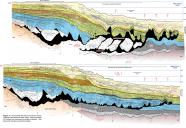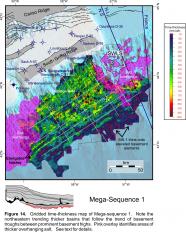Mega-sequence 1 (MS-1) – Early? to Early Middle Jurassic (duration unknown)
Mega-sequence 1 (MS-1) – Early? to early Middle Jurassic (duration unknown)
The highly rugose top basement surface described above was onlapped, and eventually overlain, by a generally low amplitude succession corresponding to MS-1 (Fig. 14). The J175 marker defines the top surface of MS-1, and corresponds to a somewhat diachronous boundary correlated across the slope region with moderate confidence. The marker separates low amplitude onlapping and infilling reflections below from generally higher amplitude continuous draping reflections above. MS-1 is only recognized on the slope, seaward of the SGR (underlying Parcels 1, 2, and 4). Correlation uncertainty of the J175 marker increases towards the northeast, towards the SWLS and Parcel 3. The age of the J175 surface, and underlying MS-1 deposits, is uncertain.
Thickness maps between the top basement surface and J175 indicate that MS-1 forms a number of narrow, northeast trending basins that are up to 700 ms (twt) thick immediately above the elongated axes of underlying basement lows (i.e. the troughs between basement highs) (Fig. 14). MS-1 deposits thin abruptly above the pointed crests of underlying fault blocks. Subtle along-strike offset of the thickest parts of these narrow elongated basins is common, and largely reflects offsets in the underlying basement structures. More regional thickness patterns are also evident. The landward termination of MS-1 is interpreted to thin and onlap the southeastern flank of the SGR or the smoother basement rocks immediately adjacent to it, as seen on profiles D1, D2 and D3. However, poor seismic imaging and potential faults in this area, increase the uncertainty of this interpretation. Further seaward, MS-1 also thins and onlaps the broader, elevated basement elements in the southern and southeastern most study area, as seen on profiles D3 and D4 (Fig. 11) and on time-thickness maps (Fig. 14).
A few normal faults extending up from the crests of basement highs appear to offset strata below and above the J175 marker, but there are no indications that the basement was actively deforming during sedimentation of MS-1. Instead, the unit appears to have more passively filled and smoothed over pre-existing topographic relief along the top basement surface, with a few normal faults developing later in response to compaction or minor basement adjustments.



